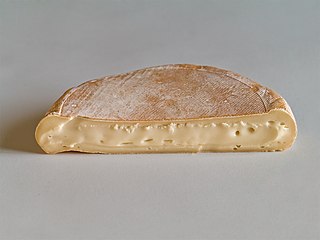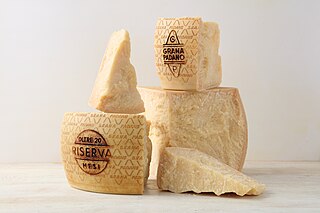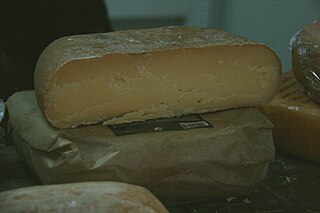
Gorgonzola is a veined protected designation of origin (PDO) Italian blue cheese, made from unskimmed cow's milk. It can be buttery or firm, crumbly and quite salty, with a "bite" from its blue veining. Outside the EU and the countries recognizing the geographical origin protection, the name "Gorgonzola" can legally be used for similar cheeses, with only the full Italian name unambiguously referring to PDO Gorgonzola. It is a famously pungent cheese.

Oka is a semi-soft washed rind cheese that was originally manufactured by Trappist monks located in Oka, Quebec, Canada. The cheese is named after the town. It has a distinct flavour and aroma, and is still manufactured in Oka, although now by a commercial company. The recipe was sold in 1981 by Les Pères Trappistes to the Agropur cooperative.

Goat cheese, goat's cheese or chèvre is cheese made from goat's milk. Goats were among the first animals to be domesticated for producing food. Goat cheese is made around the world with a variety of recipes, giving many different styles of cheeses, from fresh and soft to aged and hard.

Camembert is a moist, soft, creamy, surface-ripened cow's milk cheese. It was first made in the late 18th century in Camembert, Normandy, in northwest France. It is sometimes compared in look and taste to brie cheese, albeit with a slightly lower butterfat content than brie's typical 20% – 25% by weight.

Reblochon is a soft washed-rind and smear-ripened French cheese made in the Alpine region of Haute-Savoie from raw cow's milk. It has its own AOC designation.

Brie de Meaux is a French brie cheese of the Brie region and a designated AOC product since 1980. Its name comes from the town of Meaux in the Brie region. As of 2003, 6,774 tonnes were produced annually.

Gubbeen Cheese is a surface ripened, semi-soft, cow's milk cheese with a pink and white rind. The flavours are creamy with mushroom and nutty aftertastes but vary depending on maturity of cheese. Gubbeen Farmhouse Products also produce a Smoked Gubbeen.

Grana Padano is a cheese originating in the Po Valley, in northern Italy, similar to Parmesan. There are less strict regulations governing its production compared to Parmesan. This hard, crumbly-textured cheese is made with unpasteurized cows' milk that is semi-skimmed through a natural creaming process. To preserve the authenticity of the manufacturing processes and raw materials used to make this cheese, Grana Padano is registered as Geographical Indication in Italy since 1954 and as a European Union protected designation of origin (PDO) since 1996, and is protected in several other countries based on the Lisbon Agreement and bilateral agreements.

Époisses, also known as Époisses de Bourgogne, is a legally demarcated cheese made in the village of Époisses and its environs, in the département of Côte-d'Or, about halfway between Dijon and Auxerre, in the former duchy of Burgundy, France, from agricultural processes and resources traditionally found in that region.

Cheese is a dairy product produced in a range of flavors, textures, and forms by coagulation of the milk protein casein. It comprises proteins and fat from milk. During production, milk is usually acidified and either the enzymes of rennet or bacterial enzymes with similar activity are added to cause the casein to coagulate. The solid curds are then separated from the liquid whey and pressed into finished cheese. Some cheeses have aromatic molds on the rind, the outer layer, or throughout.

Maroilles is a cow's-milk cheese made in the regions of Picardy and Nord-Pas-de-Calais in northern France. It derives its name from the village of Maroilles in the region in which it is still manufactured.

Caprino is an Italian cheese traditionally made from whole or skimmed goat's milk. The name of the cheese derives from the Italian word for goat, capra. With modern methods of production, the cheese is made from cow's milk as well or a combination of both cow's and goat's milks. The two major styles of caprino are fresco ("fresh") and stagionato ("aged").

There are many different types of cheese. Cheeses can be grouped or classified according to criteria such as length of fermentation, texture, methods of production, fat content, animal milk, and country or region of origin. The method most commonly and traditionally used is based on moisture content, which is then further narrowed down by fat content and curing or ripening methods. The criteria may either be used singly or in combination, with no single method being universally used.

Swaledale is a full fat hard cheese produced in the town of Richmond in Swaledale, North Yorkshire, England. The cheese is produced from cows’ milk, Swaledale sheep's milk and goats’ milk.

Mallorca cheese is a Spanish cheese made exclusively on the island of Mallorca, one of the Balearic Islands in the Mediterranean Sea. It has Protected Designation of Origin and is made from the pasteurized milk of cows, goats and/or sheep which live on the island. The cheeses are slightly tapering, flat cylinders which measure 12–20 cm (5–8 in) across and 7–9 cm (3–4 in) high. They weigh from 750 to 4 kg. Mallorca cheese is produced in three types:
Murcian cheese is a fatty goats' milk cheese from the Murcia region of south-east Spain. It has a Protected Designation of Origin. The cheese is made exclusively using goat's milk of the Murcian breed from registered herds which graze freely on scrub and coarse pasture characteristic of that dry geographical zone. The cheese is made in two forms:

Swiss-type cheeses, also known as Alpine cheeses, are a group of hard or semi-hard cheeses with a distinct character, whose origins lie in the Alps of Europe, although they are now eaten and imitated in most cheesemaking parts of the world. Their distinct character arose from the requirements of cheese made in the summer on high Alpine grasslands, and then transported with the cows down to the valleys in the winter, in the historic culture of Alpine transhumance. Traditionally the cheeses were made in large rounds or "wheels" with a hard rind, and were robust enough for both keeping and transporting.

Quartirolo Lombardo is a soft cheese made with cow's milk, which has a Protected designation of origin (PDO) status.
















